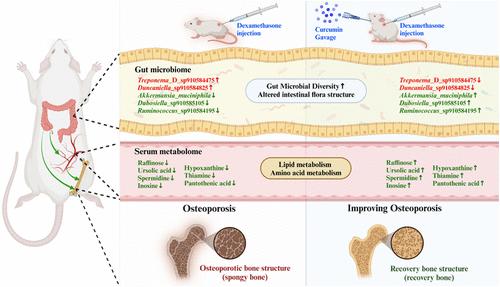Curcumin Ameliorated Glucocorticoid-Induced Osteoporosis While Modulating the Gut Microbiota and Serum Metabolome
IF 6.2
1区 农林科学
Q1 AGRICULTURE, MULTIDISCIPLINARY
引用次数: 0
Abstract
Glucocorticoid-induced osteoporosis (GIOP) is the leading cause of secondary osteoporosis. Recently, the “bone-gut axis” theory has linked bone development with gut microbial diversity, community composition, and metabolites. Curcumin, a well-studied polyphenol, shows potential in mitigating bone loss and osteoporosis. Alendronate, a standard therapeutic agent for osteoporosis, serves as a positive control in this investigation. The study demonstrates the potency of curcumin in reducing bone loss and restoring bone mineral density, enhancing trabecular parameters notably through increased trabecular number, volume, and thickness and reduced bone marrow cavity size. Gut microbiome sequencing revealed that both curcumin and alendronate treatments similarly enhanced gut microbial diversity and altered microbiota composition, increasing beneficial bacteria (Akkermansia_muciniphila, Dubosiella_sp910585105, and Ruminococcus_sp910584195) while reducing harmful bacteria (Treponema_D_sp910584475 and Duncaniella_sp910584825). Furthermore, significant changes in serum levels of metabolites including raffinose, ursolic acid, spermidine, inosine, hypoxanthine, thiamine, and pantothenic acid were observed post-treatment with curcumin or alendronate. Importantly, these beneficial metabolites and microorganisms were negatively correlated with inflammatory cytokines. In conclusion, curcumin holds promise for use against GIOP by modulating the gut microbiome and serum metabolome as well as reducing systemic inflammation.

姜黄素通过调节肠道微生物群和血清代谢组改善糖皮质激素诱导的骨质疏松症
糖皮质激素性骨质疏松症(GIOP)是继发性骨质疏松症的主要原因。最近,“骨肠轴”理论将骨骼发育与肠道微生物多样性、群落组成和代谢物联系起来。姜黄素是一种经过充分研究的多酚,显示出减轻骨质流失和骨质疏松症的潜力。阿仑膦酸钠是一种标准的骨质疏松治疗药物,在本研究中作为阳性对照。该研究表明姜黄素在减少骨质流失和恢复骨矿物质密度方面的功效,通过增加小梁数量、体积和厚度以及减少骨髓腔大小来增强小梁参数。肠道微生物组测序显示,姜黄素和阿仑膦酸钠处理同样增强了肠道微生物多样性,改变了微生物群组成,增加了有益细菌(Akkermansia_muciniphila, Dubosiella_sp910585105和Ruminococcus_sp910584195),减少了有害细菌(Treponema_D_sp910584475和Duncaniella_sp910584825)。此外,姜黄素或阿仑膦酸治疗后,血清代谢物水平发生了显著变化,包括棉子糖、熊果酸、亚精胺、肌苷、次黄嘌呤、硫胺素和泛酸。重要的是,这些有益的代谢物和微生物与炎症细胞因子呈负相关。总之,姜黄素有望通过调节肠道微生物组和血清代谢组以及减少全身炎症来治疗GIOP。
本文章由计算机程序翻译,如有差异,请以英文原文为准。
求助全文
约1分钟内获得全文
求助全文
来源期刊
CiteScore
9.90
自引率
8.20%
发文量
1375
审稿时长
2.3 months
期刊介绍:
The Journal of Agricultural and Food Chemistry publishes high-quality, cutting edge original research representing complete studies and research advances dealing with the chemistry and biochemistry of agriculture and food. The Journal also encourages papers with chemistry and/or biochemistry as a major component combined with biological/sensory/nutritional/toxicological evaluation related to agriculture and/or food.

 求助内容:
求助内容: 应助结果提醒方式:
应助结果提醒方式:


